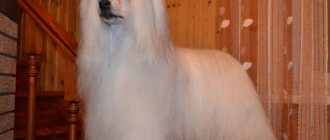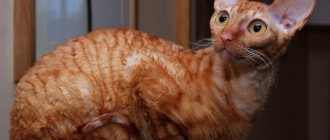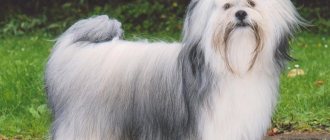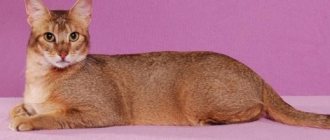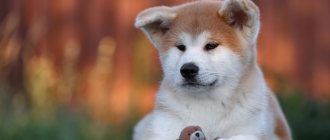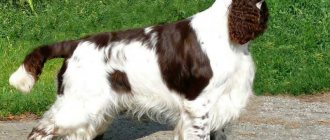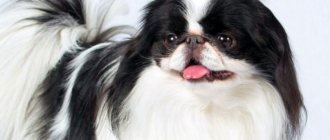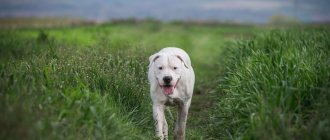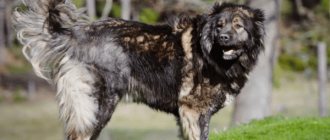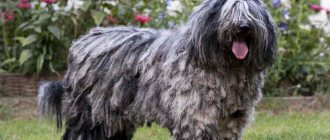Many potential owners of Shar Pei look first of all at the appearance of their pets, thinking that this is a decorative breed of dog. However, this is not the case.
Shar Peis have a very rich history of keeping, and they were originally fighting dogs.
Now they have become excellent watchmen, but this is not a reason to discard their past.
Despite their cute exterior, they are very proud and noble.
However, dogs of this breed have their own characteristics and need proper care. How to ensure this will be discussed in the article.
Basic rules of care
Shar Pei can easily be kept in an apartment, the main thing is to follow some rules for caring for this breed:
- Place the dog bed out of the way and away from a draft. The place should be away from wind, direct sunlight and household clutter;
- Try to choose bedding from material components;
- Food bowls should always be clean and appropriate for the dog's height. You can also place an oilcloth or diaper under the bowls so as not to pollute the floor;
- The breed has no undercoat and practically does not shed, but it needs to be brushed every three days, and during shedding - every day. You will have to wipe the folds on the Shar Pei's face and body from time to time;
- You need to walk your dog twice a day, and the walk itself should last about an hour. You should either simply walk with the animal or engage it in physical activity so that it can release its energy;
- Shar Pei need to be bathed infrequently, mostly when they get dirty. On average, this procedure is repeated about twice a month;
- You also need to feed your dog twice a day - morning and evening. Feeding is another important aspect that deserves additional influence. The food must be of high quality and the products must be fresh.
The Shar Pei is an ideal dog for the home not only because it practically does not shed, but also because it does not have a specific dog smell.
Expert opinion
Kozhevin Semyon Kirillovich
Expert dog handler.
“The main thing you need to know is that the Shar Pei is absolutely not suitable for being kept outside. It does not have an undercoat, so any frost or sunlight can adversely affect the health of the pet. You also don't need to bathe your dog often; you wash off all the special coating on your dog's skin, leaving it vulnerable. But if you decide to keep your Shar Pei outdoors, you will have to tinker with setting up a special enclosure for him.”
Walk
Shar Peis require long walks twice a day for 30-60 minutes. To maintain muscle tone, they must be mobile. While being active outside, your dog will be calmer at home. They are great running or cycling companions.
The coat of this breed is short, without undercoat. Therefore, in summer, to avoid overheating, it is better to walk early in the morning and in the evening, when the heat subsides. And in winter, wear clothes for dogs.
How to feed?
An adult dog of this breed is fed twice a day, and the amount of food is calculated based on the dog’s weight - a certain proportion is maintained.
What to feed the dog - natural food or artificial food - is the choice of only the owner. Any food will be appropriate if you take proper care of the quality of the product.
If you choose industrial food for feeding your Shar Pei, then buy only those that are at least premium class. You must be sure that what is inside the package is actually meat and not substitutes or cheap offal. Therefore, read the ingredients carefully. Also, the feed must contain at least 12% fat and 23% protein.
NOTE!
High-quality food does not have a pronounced flavored odor. Its color is uniform (dark brown).
If your choice fell on natural nutrition, then you should know that creating a proper and balanced diet is a lot of work, so it’s not the first time it’s better to contact a veterinarian for help.
The Shar Pei menu should include:
- Lean meat and offal, which should make up at least 30% of the total diet - turkey, beef, chicken, rabbit;
- Boiled sea fish;
- Fermented milk products and eggs, if you are not allergic to them;
- Porridge – buckwheat, rice, oatmeal, millet, barley, pearl barley;
- Oil (olive, vegetable);
- Fruits and vegetables;
- Vitamins.
The food in the bowl, like the water, should be at room temperature and fresh. You cannot feed your dog from your table, as this will lead to health problems.
Prohibited for Shar-Pei are sausages, smoked and baked goods, river fish, fatty, spicy, salty foods, spices, sugar and spices, lamb, pork and bones, which Shar-Pei are not allowed to eat at any age.
Content
These truly beautiful, kind and intelligent dogs are among the pets that are kept both in an apartment and in a spacious country house. Medium in size, Shar-Peis do not take up space and are comfortable in confined spaces.
The main thing for them is the attention of the owner. But they are demanding when it comes to temperature conditions. They do not tolerate temperatures above +27 °C. Therefore, in the summer, in extreme heat, long walks are contraindicated for them. During this period, they are usually walked from 5 am to 11 am, in the evening - after 5 pm.
They are not suitable for street keeping, especially on a leash. Shar Peis love free movement around the territory. But in a car, due to their small dimensions, they are easy to transport. And they can handle the road well.
Attention! Dogs are distinguished by their cleanliness. After six months, it is enough for them to walk twice a day to keep the house or apartment clean.
In the apartment
For those who plan to keep a Shar Pei in an apartment, it will not cause any trouble. The pet is not subject to shedding, the fur will not bother anyone. The pet is distinguished by its ability to get along with other animals.
When determining a place for it, you need to remember about its protective qualities. Therefore, it is important that he can view the front door from it, as well as the maximum number of rooms. If not, it will worry him, because he will have nothing to protect.
Can he live on the street?
The guarding qualities of the Shar Pei lead to the fact that people want to have such a dog in their yard. It is unacceptable. Dogs have sensitive skin without a warm undercoat.
Important! Whenever there is a cold snap, they freeze, and in the summer they succumb to the heat. For this reason, keeping them in the yard is contraindicated. But, nevertheless, when it is really needed, then in winter it should be kept in an enclosure that is heated, or in a booth.
Relationships with children
If a Shar Pei lives in a family where he is loved and understood, he will not claim leadership. He treats children with care and tenderness and, during their sloppy games, will not express displeasure, but will simply find a way to evade.
True, when meeting a child for the first time, he does not always understand why the person is suddenly so small. But a little later, he will slowly come up and definitely lick the child’s outstretched hand.
Muzzle
Showing calm, independence, loyalty and devotion in the family, the Shar Pei is wary of strangers. In addition, his deep-set eyes limit his vision, which makes him afraid of rapid movements.
Walking them without a muzzle, as well as other dogs, is not recommended. You should choose a better leather muzzle for him, which is not as dangerous as the one with a metal mesh.
Harness
In addition to the muzzle, the same mandatory attributes when walking a Chinese Shar-Pei are a harness and a leash. And this is quite reasonable, because some of their representatives strive to catch pigeons on walks, rush headlong after cats, and behave aggressively with other dogs. In this case, it is always important to rein them in. And the very appearance of the dog, its powerful fangs, inspires fear in others.
How often should you go for walks?
This breed needs to be walked every day, or preferably several times a day. She needs to run and explore a lot.
If it’s cold and raining outside, it’s better to limit yourself to thirty minutes in the fresh air.
If the weather is favorable, then stay outside longer. In this case, the dog can be walked for an hour or an hour and a half without harming the health of the Shar Pei.
History of the origin of the breed
Shar Pei is a very ancient breed of dog. The exact history of its origin is still unknown. There is information that the great emperor of China ordered the destruction of all stud books, which described in detail the history of these amazing dogs . There is a strong opinion among scientists that the ancestors of the Shar Pei were the first mastiffs and smooth-haired Chow Chows, but this is evidenced only by individual structural elements and character traits.
This is interesting! It was possible to establish for sure that the breed is at least 3000 years old. In the early 30s of the twentieth century. In its homeland in China, the breed began to degenerate; the crisis intensified in the 50s, when these pets began to be considered a bourgeois relic.
In 1971, they managed to bring several Shar Pei puppies abroad. From that moment on, the revival of the breed began. The international standard was approved in 1976. It is worth saying that in 1978 this dog was recognized as the rarest in the world and included in the Red Book; this is a unique case for dogs.
In Russia, Shar Peis became known only in the early 90s. At first it was a rare and exotic breed, but over time, Shar Peis gained great popularity among dog breeders.
Is a muzzle necessary?
To understand whether Shar Peis need a muzzle, you need to remember for what purposes this breed was originally used and for what purposes it is used now.
In ancient times, Shar Peis were a fighting breed of dog, but now they are excellent watchmen and security guards. That is, they may well show aggression if they feel threatened. For this reason, no matter how confident you are in your dog, it is by no means decorative, which means it will need a muzzle.
You can make a muzzle to order or buy a ready-made one in a special store.
IMPORTANT!
To choose the right muzzle, you must know the length of the muzzle, skull and head circumference. Together with these indicators, you can choose a muzzle in consultation with the seller.
Also, do not choose an iron one - it can be traumatic for the animal itself and for humans. It is better to opt for leather.
You need to wear a muzzle in crowded places.
Character traits
The biggest misconception is to think of the Shar Pei as a big plush toy and treat it as such. This is a serious dog (remember that the Chinese developed its fighting qualities), sometimes aggressive towards people it does not know, or towards some other animals. She is friendly towards children, if only the children grew up with her in the same family, before her eyes.
These dogs are distinguished by high intelligence, they capture the nuances in the mood of their owners, understand them and, surprisingly, make their own decisions based on the information received. In general, they love their owners very much, are devoted to them, and may even experience a feeling of jealousy.
However, what characterizes not all four-legged friends, the Shar Pei is unobtrusive: when its owners return from work, it will not jump like a little one, make a puddle, or offer toys for general entertainment.
They are not very easy to train, because they consider themselves leaders and love autonomy and independence.
The character of this dog will not allow it to bark without any reason, as often happens with representatives of other breeds. For example, if a stranger is simply passing by, the Shar Pei will only follow him with his gaze. If a stranger tries to open the gate and get inside, the Shar Pei will bark until the concerned owner comes out to investigate the situation.
The characteristics of this breed are such that a person will not be advised to get a Shar Pei if he:
- not a leader by nature,
- afraid of dogs
- never had pets before,
- does not have time to spend with a new pet.
And another important note: it is unacceptable for one of the owners to be strict with the Shar Pei, and the other (for example, the wife) to be too soft. This disorients the dog, for which it is important to distinguish who is in charge in the house, and for whom he, the Shar Pei, can become a leader.
How to toilet train a puppy?
To toilet a small Shar Pei
- First, find a place that is comfortable for your puppy to go to. It should be close to home;
- In order for the puppy to understand that this is exactly the place, you can put there the diaper that the dog wore at home;
- Guess what time the Shar Pei goes to the toilet and shortly before that, bring him to the designated place;
- Don't rush the puppy, let him concentrate. If the puppy managed to do the job, then praise him and take him home;
- In the future, you can gradually adjust your walking time to whatever is convenient for you.
Shedding in dogs is a natural process.
Wool protects the dog from ticks, fleas and other parasites, infections and bad weather. But it also brings humans and animals closer together. Any dog is blissful when his coat is stroked, and the owner is always proud of his stately and representative pet.
We recommend reading: Make a DIY Nail Board
However, there is one “but” in this ideal relationship: pets periodically renew their coats, getting rid of old hair. And then their owners puzzle over how to deal with the ubiquitous fur...
How to properly clean your ears?
Shar Pei ears should be treated at the end of each week. This should be done with a cotton pad moistened with warm water or a special solution purchased at a pet store. You should not clean with a cotton swab, because it can damage the eardrum and the delicate skin of your dog’s ears.
You must teach your Shar Pei to this procedure from childhood so that it does not break out. The Shar Pei's evasion from your hands can cause injury.
To properly clean your Shar Pei's ears, your brushing movements should be gentle, but firm and quick.
NOTE!
Shar Peis have narrow ear canals and poor ventilation in them. For this reason, special attention should be paid to their ears, as they can easily become infected. Try not to let water pour into them when swimming. Also, if you see that your dog often shakes his head and scratches his ears, then it is better to show him to the veterinarian.
Description of the breed
The Shar Pei evokes mixed emotions in people. Its peculiarity is the folds that cover the body, especially on the muzzle. It looks like his coat is velor, but in reality it is very hard.
Not everyone, seeing such a pet for the first time, believes that in the past these were fighting dogs. But stretching skin reminds us of this - it protected animals from fatal injuries .
Because of the purple (lavender) color of the tongue, the pet is called “the dog that licked the sky.” There are two types of animals: mini-pei - a dwarf representative, according to the standard - this is a breed defect; and classic (European, American) Shar Pei.
Exotics refer to small-sized Molossians that look like this:
- The height of an adult is 44−51 cm, weight varies between 18−35 kg. Dogs live on average 10-12 years.
- The head is large with numerous folds, the skull is flat. The nose is black and large. The mouth is dark purple. Strong jaws, scissor bite.
- The ears are fleshy and small in size.
- Small eyes with dark irises.
- The body is strong, muscular, compact. The neck is of medium length, very strong. The body of puppies is completely covered in folds; as they grow older, they remain only on the neck and head.
- The chest is quite wide and deep. The shortened back goes into a strong lower back.
- The limbs are muscular, strong, the tail is thrown over the back, rather short.
Grooming
Caring for the Shar Pei's coat is quite simple:
- A Shar Pei's coat should be brushed no more than once every three days. During shedding, you will have to do this procedure daily.
- Also, you do not need to constantly wipe the folds on the dog’s face and body; it is enough to do this once every two weeks, but a little more often if the dog is outside very often and for a long time.
- This breed does not like water procedures, so it will not need to be bathed often either. This can be done 1-2 times a month. But don’t rush to drag your dog into the bath every time it gets dirty. It may be enough to remove the dirt with a napkin. Also, a healthy dog should not emit any unpleasant odors.
Vaccinations
2 (two) weeks before vaccinations, the puppy needs to get rid of worms (our kennel uses the drug “Tenover”, 1 tablet per 4 kg of weight, given once). The first vaccination is given at 2 months (excellent results were obtained using the Nobi-vac DHPPi+L vaccine). After 3 weeks, revaccination is performed (DHPPi+LR). 2 weeks after revaccination, it is necessary to re-give the anthelmintic. The next revaccination is performed after a complete change of teeth (usually at 6-7 months). When using the Nobi-vac vaccine, revaccination is also carried out with the Nobi-vac vaccine (DHPPi+LR) at 12 months (1 year). When using other types of vaccines (“Hexadog”, “Adenomune”, “plague”, “enteritis parvovac carnivorum”, etc.), it is necessary to strictly follow the instructions of the developers regarding the timing of their use. Two weeks before revaccination, you need to drive away the worms again. In the future, revaccination is carried out once a year (preferably no later than two weeks before the expiration date of the previous vaccination). An anthelmintic for prevention is given 2 times a year - spring-autumn, but no later than two weeks before revaccination. The Shar Pei is considered to be the veterinarian's "favorite dog." With proper care and diet, Shar-Peis are actually very strong and hardy dogs with strong immunity to common diseases such as enteritis and plague. Like any other breed, Shar-Peis have their own problems that are unique to representatives of this breed, but it is not at all necessary that your puppy will encounter these problems. Eyes
Newborn Shar Pei puppies' eyes open, like puppies of all other breeds, at 10-14 days of age.
Shar-Pei puppies are distinguished by the fact that they open their eyes and, as a rule, close them immediately (this is due to the presence of thick, fleshy eyelids). Very often, owners do not even notice that their puppies have opened their eyes and are quite sure that it is still too early, and over time the eyes will open. This threatens that such puppies will develop corneal erosion, and over time, ulcers will appear. If nothing is done, the ulcers can perforate, leading to blindness. To avoid these problems (this only applies to puppies whose eyes are either completely closed by the 14th day, or only slits are visible), on the 15th day, start smearing the baby’s eyes with eye ointment (suitable: tetracycline, gentamicin, hydrocortisone eye ointments) . This is done as follows: wash your hands, make sure you take a tube of eye ointment, apply about 0.5 cm of ointment to your index finger. Pick up the puppy. It is better to do the procedure together. Calm the puppy, when the puppy is used to the hands and has calmed down, use your finger to apply the ointment to the eyelids at the base of the eyelashes. Some of the ointment will remain outside, but what gets into your eyes is quite enough. Do not try to force your eyes open under any circumstances. For prevention, this procedure is carried out once a day until the puppy reaches the age of 1 month or until the eyes are completely open. If you have purchased a puppy with problem eyes, do not rush into surgery. In most cases, by the age of 4 months, the Shar-Pei's eye muscles become stronger, and the problem disappears on its own. But do not forget that the eyes of a Shar-Pei puppy require daily treatment: 1. The same eye ointments, but 2 times a day, morning and evening. 2. Special eye drops. You can make them yourself (1 ml gentamicin + 1 ml hydrocortisone + 5 ml novocaine + 10 ml boiled cold water). Drops can be bought at the pharmacy (but the result will be worse): if the eyes are severely damaged - garazon, if the eyes are open but slightly watery - sofradex. Drop 3 times a day (you will purchase all medications at a “human” pharmacy). If you find a thorn in your puppy - clouding of the cornea, do not be alarmed - you need to add a protein-sugar suspension to the ointment and drops and the thorn will quickly resolve. Recipe: hard boil one egg, remove the shell while hot, cut off the sharp side, remove the yolk with a spoon. Pour sugar into the resulting cup. Place the protein cup with sugar in a glass and leave in a warm place for three hours. After 3 hours, a liquid will form in the cup - this will be the desired remedy for removing the cataract. Store in the refrigerator, drip 5-6 times a day (the thorn will resolve within 3-4 days). To wash your eyes, you can use the following recipe: 1 teaspoon of natural honey + 200 ml of water, boil for 5 minutes over low heat. Cool before use. Rinse eyes several times a day as needed. If an operation to eliminate entropion (entropion) is unavoidable, it is better to do it after 4 months, since the folds on the puppy’s head increase with age, and an early operation will have to be repeated over time. The older the puppy is at the time of surgery, the lower the likelihood of returning to the surgeon. With the help of our recipes you can delay the operation as much as possible. The operation to eliminate entropion (turning of the eyelids inwards) is described in detail in Di Gannon’s book “Chinese Shar-Pei”. Lips
Shar-Peis often have a problem called “tight lip.”
With this defect, the lower lip curls up and fits tightly over the lower teeth. This causes discomfort to the dog while eating; over time, the bite changes, the lower jaw stops developing, and as a result, underbite occurs. If a “tight lip” is detected, the dog requires urgent surgical intervention. Unlike problems with the eyes, you shouldn’t hesitate here; this problem will not go away on its own. Typically, this operation is performed between 2 and 4 months (before or during the change of teeth). If the operation is done on time, the bite will be restored and there will be no further problems. Ears
Shar-Peis have very narrow auditory canals, tightly fitting ears prevent aeration (air access), so an infection that gets inside quickly develops and becomes a chronic form of the disease.
The Shar-Pei's ears must be constantly monitored, the outer shell and the upper part of the ear canal (only where you can reach with a cotton swab, but not with a match) kept clean. At the slightest inflammation (the puppy begins to pay attention to the ears, scratches them with his paw, shakes his head), immediately apply drops to the ears. For the initial stage of the disease, Otinum, Otipax, Sofradex drops are suitable, for a more advanced problem - Garazon. If there is the slightest problem, your dog’s ears should be shown to a doctor. To treat otitis media, you can use wicks (tampons) soaked in ioddicerin. Recipe: wrap cotton wool around a match, measuring the resulting swab with the size of your dog’s ear canal, remove the swab from the match, soak it in ioddicerin (sold in any “human” pharmacy), and place it deep into the ear canal. Hold the dog for 10 minutes without letting it get rid of the tampons. Let go and let the dog shake the tampons out of its ears. This procedure simultaneously cleanses and deeply warms the ears (do it once a day, after the last walk, for 5-7 days). Skin
The skin is the Shar-Pei's most vulnerable spot. All Shar-Peis are allergic; with allergies, the skin suffers first of all. It is because of allergies that the misconception has arisen that the Shar-Pei's folds need to be constantly washed, sprinkled and ventilated. In 99 cases out of 100 allergic diseases in Shar-Pei, in which the skin suffers, improper nutrition is to blame (see section Nutrition). Shar-Peis with short hair (horst) and dilute dogs are most susceptible to allergic diseases. Very often, the cause of allergies is common fleas. With each flea bite, the dog receives a dose of toxin, resulting in itching and scratching. It is best to rid your dog of fleas immediately, as one bite is enough for a sensitive animal. Shar-Peis often experience diaper rash in the neck area. Food, getting into the folds of the suspension, corrodes the code. Therefore, after eating (especially if the Shar-Pei eats cereals and not food), the dog needs to remove any remaining food from its muzzle and dewlap with a damp towel. Then, if the skin is inflamed, sprinkle the reddened areas with baby powder. Shar-Pei shedding should not be confused with skin (fungal) diseases. Even veterinarians who have not previously encountered this problem often get burned by this. Shar-Peis shed very sloppily. Brush dogs (long-haired) develop large bald patches, and short-haired dogs look as if they are “moth-ridden.” When shedding, the old fur is easily removed (removed in layers). To speed up the shedding process, all fur that can be easily removed must be removed (plucked). During the shedding period, the Shar-Pei must be brushed several times a day with a special rubber brush (for smooth-haired dogs). Dead fur irritates the skin, resulting in itching and scratching. Shar Pei skin has one advantage - it heals wounds very quickly. Shar Pei skin does not need to be sewn. Any wound heals within 2 days. Apply “rescuer” balm (sold at a regular pharmacy) to a fresh wound, repeat the procedure 3 times a day. There is no need to process anything else.
Teeth cleaning
Shar Peis are a breed that is prone to developing tartar in the mouth. For this reason, they need to brush their teeth regularly, as well as give them special toys.
If you have a puppy, then you need to get used to this procedure now. To start, simply inspect his mouth several times a week and run your finger over his teeth.
Also continue to examine your dog's teeth after they are replaced. From time to time you can wipe them with lemon or tomato juice. This treatment must be done from the roots. You can do this cleaning using a cotton pad.
Some owners sometimes give the dog just a tomato to eat, but this vegetable is not the most beneficial for the dog’s digestion, so there is no need to overuse it.
Also in veterinary stores there are special treats and preparations that should be used to prevent tartar. They can be given to your pet every day without harm to health.
IMPORTANT!
If the formation process has already started, then it is better to contact a veterinary clinic. There, the dog will have the accumulated tartar or plaque removed mechanically.
Bathing
Experienced owners recommend washing your Shar Pei 3-4 times a year during shedding. This will help the dog quickly replace the old coat with a new one. But frequent bathing leads to dandruff due to the loss of natural lubrication on the skin.
It is necessary to accustom your dog to bathing from an early age. The water should be comfortable for the pet, at normal temperature. It is better to use shampoos specially created for short-haired dogs or tar soap as washing products. This will help protect your Shar Pei from skin irritation.
The foam must be washed off without leaving any traces, it is especially important to wash the skin folds. It is important to protect your Shar Pei from water and foam getting into its ears. You don't have to wash his hair at all. Water in the ear canals can lead to serious infections in this breed.
Proper drying is also important when it comes to caring for your Shar Pei after a bath. You need to thoroughly wipe the folds of the skin, and then dry the fur with a hairdryer. You can additionally use talcum powder or dog powder to remove moisture between the folds.
You can take him out for a walk no earlier than 3-4 hours after swimming. See the article: How to find out the breed of a dog and provide it with proper care?
Grooming
The Shar Pei's numerous folds do not require special care or regular wiping. It is enough to comb the wool once a week, and wash it once every 3-4 months.
You should brush your pet with a short-bristled brush or a special glove. You can also brush the coat while bathing using a rubber brush.
Beginning owners often wonder whether it is possible to keep a Shar Pei outside in winter or walk it in extreme cold? Due to the almost complete absence of undercoat, Shar Peis do not tolerate cold well. They cannot live outside in a booth, but they can easily endure winter walks. Especially if the owner bothers to purchase a dog overall.
The condition of the coat largely depends on what you feed the Shar Pei puppy from the first days of being in the house. Only high-quality nutrition will help maintain shine and prevent skin rashes.
Ear care
The structural features of Shar Pei ears make them susceptible to various infections. Therefore, it is necessary to examine your ears up to 2 times a week. If your pet frequently shakes its head and there is an unpleasant odor in the ear canal, you should immediately contact a veterinarian. You should also not get your ears wet when swimming.
Dental care
Shar Pei's teeth are naturally good and do not require special care. They do not need to be constantly cleaned and examined by a veterinarian. However, it is necessary to monitor the formation of the correct bite in the puppy, and, if necessary, perform correction surgery. If tartar appears, have it removed immediately at a veterinary clinic.
Eye care
The Shar Pei's eyes need to be wiped with a soft cloth every morning to remove traces of souring. The cloth should be lint-free so as not to cause eye irritation. A healthy Shar Pei requires minimal care and maintenance.
Nail trimming
Proper care of a Shar Pei requires trimming its nails at least once a month.
Nails that are too long can cause your pet's toes to dislocate. The correct length is when the tips of the claws are level with the pads of the paws.
The claw must be trimmed carefully so as not to touch the vein. To do this, you need to look at the claw in the light and cut off all excess with a nail clipper, without stepping beyond the border of the vein. If bleeding does occur, you need to wipe the claw with disinfectant and stop the bleeding, holding the cotton wool until the bleeding stops completely.
Many dogs are afraid of this procedure. Therefore, puppies need to be accustomed to it as early as possible. You must act carefully and gently, talking calmly with your pet, and then be sure to reward him with a treat.
What vaccinations should I get?
The breeder gives the puppy his first vaccinations at 1.5-2 months. After two weeks, the course should be repeated. Remember that the puppy can be taken outside only 10 days after repeating the course.
Shar Pei vaccinations are usually given on the following schedule:
- From 8 weeks to two months, the dog is vaccinated against distemper and viral enteritis;
- Course repetition;
- At six months the dog is vaccinated against rabies;
- There are also special vaccinations against parasites, which also need to be given to your pet, although they are optional.
Feeding the Shar Pei
From birth to one month of age, puppies feed only on their mother's milk. As they develop, they become interested in more adult foods. Depending on the type of content (natural or industrial food), the first complementary foods are given:
- minced meat, vegetables, dairy and fermented milk products, egg yolk;
- soaked dry food or canned food for puppies.
New food is introduced starting with small portions and gradually increasing the volume. It is necessary to monitor the occurrence of an allergic reaction.
At 2 months, the puppies' diet consists of 1/3 mother's milk and 2/3 adult food.
At about three months, the puppy moves to a new home. If the breeder kept the Shar Pei on a natural diet, and you plan to use dry food (and vice versa), then the transition should be smooth, within 1-2 weeks.
Shar Pei is in heat
When does Shar Pei go into heat? And how long does it usually last?
Female Shar-Peis come into heat at the age of 8-12 months. After that, it is repeated every six months, that is, it happens twice a year.
Its duration is 18-20 days. But this is only an average, there are deviations. This process requires an individual approach on the part of the owner.
NOTE!
If estrus occurs earlier than 7 months and later than 15 months, or the interval between estrus is less than 4 and more than 9 months, then this indicates serious problems with the dog’s health. You will need to contact a specialist.
Mating a bitch is a very important period. She will need to be closely monitored so as not to miss the beginning of this period. The female accepts the male on average on the 12th day of estrus, but the full readiness of the female can only be determined by a mating instructor.
Control mating is carried out 48 hours after the start of estrus. There is also an age at which this process will be most favorable. For females this is after 20 months, and for males - after 24 months.
Raising a Shar Pei
Anyone who dares to adopt a Shar Pei must be prepared for the fact that raising this dog is not easy. At the most inopportune moment, the pet shows character and becomes stubborn. This dog remembers commands that, being stubborn, does not want to carry out. Therefore, from the very first time we must try to make him accept the authority of the owner, not be afraid, but feel that the relationship between them is trusting, partnership .
This is important, because dogs of this breed have a developed sense of self-esteem, and therefore will not easily obey. To do this, they also need to be respected.
If contact is successful, then he is able to lift the owner’s bad mood and knows how to behave with each of the family members .
How to care for puppies
As for Shar Pei puppies, care and maintenance begins with the kitten being weaned from its mother. This is done at two months of age. Until this moment, milk serves as food for them, with which the animals receive antibodies that contribute to the development of immunity.
Note! Before picking up a small pet from a breeder, it is important to make sure that he is healthy and vaccinated, ask how to care for a Shar Pei, how to feed it and buy the food that the baby is used to so that he does not develop allergies.
When you bring a puppy home, it is important to immediately let him know who is the owner and has authority. It is also necessary to begin education without delay. The first walk can be organized after the animal is vaccinated. First, it is better to choose a deserted, quiet place.
The time a Shar Pei spends outside can be gradually increased.
Characteristics of the Shar Pei breed
The main distinguishing features of representatives of this ancient breed are folds on the head and shoulders, as well as a peculiar muzzle, reminiscent of a hippopotamus. Any description of the Shar Pei breed always includes the tongue of these four-legged friends, colored blue-black and indicating a connection with the Chow Chow.
- WeightThe body weight of dogs depends on gender. The weight of females varies from 18 to 25 kg. Males usually have a body weight of 25 to 30 kg.
- Height at the withersThis parameter does not depend on gender: according to the breed standard, both “girls” and “boys” have a height of up to 51 cm with a lower limit of 46 cm.
- Color One of the oldest dogs has six acceptable colors according to the standard: black, lilac, cream, sand, red and yellowish-brown.
- Lifespan The Shar Pei lives from nine to 11 years. Contrary to the interpretation of the folds on its forehead, the breed is not distinguished by longevity.
- Personality: This dog looks like a thoughtful Chinese philosopher. He looks down on his own kind and does not want to meet other dogs in the yard. He will listen only to a leader who is able to teach him something. A person with a weak character will not be able to gain power over a four-legged pet. At the same time, they love their human family and are ready to defend it at any moment, boldly entering even into an unequal battle. In general, the character of the Shar Pei is balanced and calm.
- Intelligence These dogs are considered very intelligent, like other breeds known since ancient China. Shar Peis make all decisions carefully and thoughtfully, without giving in to emotions.
- Security and guard potentialInitially, animals were bred precisely for the purpose of protecting homes, so their security and guard qualities are at their best. Many novice dog breeders are sincerely surprised by this fact, naively believing that wrinkles on the forehead indicate that the dog is decorative.
The Chinese believed that the Shar Pei's blue tongue was a totemic organ that could scare away evil spirits from the dog's owner and protect against evil spirits.
Shar Pei breed training
Thoroughbreds tend to be dominant and are quite independent. This is exactly what can become a problem in education and training. The Shar Pei needs an owner with strong nerves and a strong spirit, otherwise the dog will quickly seize the initiative.
From the very first days it is important to show the puppy who is boss in the house; only by taking this for granted will the dog listen and obey. Shar Peis are stubborn, and, as the owners put it, “can turn on the stupid,” in which case the owner should be more cunning and wiser. With the right approach, the dog will quickly learn the basic principles of living in a house, will not spoil things and will get used to the street.
A number of professional recommendations will help facilitate the learning process:
- The baby should be taught as soon as he gets into the house, and the general course of training should begin with the pet from 3 months.
- Early socialization is important for Shar Pei, that is, the puppy needs to be introduced to other people, pets, change walking routes, etc.
- When training, the owner needs to be restrained - aggressive behavior and screaming are unacceptable.
- The dog must learn a basic set of commands; this will greatly facilitate further training and comfortable coexistence.
- Strangers should not be allowed to raise the dog.
If a Shar Pei is not trained, it can grow up to be aggressive and headstrong. It is almost impossible to retrain an adult dog.
